Hyaluronic Acid vs. Neuromodulatory Treatment: What every doctor should know before starting aesthetic medicine.
Aesthetic Medicine has become one of the most in-demand branches of the healthcare sector, not only due to the growing interest among patients in looking and feeling better, but also because of the opportunity it represents for physicians seeking to reinvent their careers, gain professional independence, and improve their quality of life. Among the most well-known and sought-after treatments by patients are hyaluronic acid and neuromodulators, commonly known as Botox.
In this article, we explain in a clear, professional, and scientifically based manner the main differences, indications, and potential results of these two treatments. If you are a physician considering entering the world of Aesthetic Medicine, this knowledge is essential. Additionally, at the end of the article, we'll tell you how you can receive comprehensive training in these two techniques with CIME Academy.
What is Neuromodulatory Treatment and how does it work?
Purified botulinum toxin type A works by blocking the release of acetylcholine at the neuromuscular junction, which causes temporary muscle relaxation, making contraction smoother or completely blocking it. In Aesthetic Medicine, it is used to treat and prevent dynamic expression lines, especially in the upper third of the face: between the eyebrows, forehead, and crow's feet, thereby achieving a more relaxed and youthful appearance.
Although these two treatments are often compared as if they were interchangeable, they are actually complementary — not competitors, as you’ve read earlier.
By combining both treatments, you can achieve a synergistic effect that enhances overall facial harmony. Each treatment typically focuses on different facial areas, as shown in the table below.
Characteristics |
Neuromodulatory Treatment |
Hyaluronic Acid |
|
Most treated area |
Upper third of the face | Middle and lower third |
|
Action |
Muscle relaxation | Volumizing, hydration |
|
Onset of effect |
48-72 hours | Immediate |
|
Duration of effect |
4 to 6 months | 9 to 18 months (depending on product) |
|
Reversibility
|
Not reversible | Reversible with hyaluronidase |





